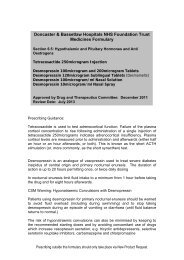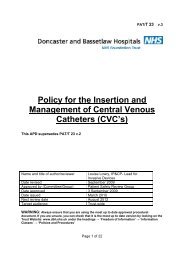surgical treatment for a prolapse - Doncaster and Bassetlaw ...
surgical treatment for a prolapse - Doncaster and Bassetlaw ...
surgical treatment for a prolapse - Doncaster and Bassetlaw ...
You also want an ePaper? Increase the reach of your titles
YUMPU automatically turns print PDFs into web optimized ePapers that Google loves.
Sacrospinous fixation<br />
To hold the vagina up more strongly, sometimes a stitch or two is put in<br />
deeper inside you. This stitch goes in to a strong ligament in the pelvis, the<br />
sacrospinous ligament. This part of the operation is called sacrospinous<br />
fixation. This part of the operation aims to prevent your <strong>prolapse</strong> coming<br />
back <strong>and</strong> also helps to keep the normal length of your vagina if you are<br />
sexually active. There is a risk with this extra fixation stitch that damage<br />
can occur to blood vessels, bowel, urinary system or nerves. The stitch<br />
also makes the operating time longer.<br />
Sacrocolpopexy<br />
If the <strong>prolapse</strong> is complicated or has come back after surgery, it may be<br />
necessary to per<strong>for</strong>m an operation through a cut in your abdomen. The<br />
sacrocolpopexy fixes your vagina to the bone at the back of your pelvis<br />
(the sacrum) to give stronger support. Material or mesh is often used <strong>and</strong><br />
this helps to hold things in place. There is a small risk that this material<br />
can cut through into the vagina or get infected. Because the bowel <strong>and</strong><br />
urinary systems are close by, there is a risk that they could be damaged in<br />
this operation. A further operation may then be needed to sort out these<br />
problems. Because the sacrocolpopexy is per<strong>for</strong>med through a cut in your<br />
abdomen, the operation usually takes longer to carry out <strong>and</strong> longer to<br />
recover from than surgery done through the vagina.<br />
Posterior intravaginal sling plasty<br />
Sometimes when the vagina <strong>prolapse</strong>s after a hysterectomy, a mesh is<br />
used to anchor the vagina. The operation is done through the vagina. You<br />
will also have two small cuts on your buttocks.<br />
As the mesh lies on either side of the rectum, there is a small risk that the<br />
rectum could be injured during the operation or later when the tape erodes<br />
through. Should this happen, the mesh is removed <strong>and</strong> usually the rectum<br />
heals over. Recovery is as following repair operations.<br />
What sort of anaesthetic will I have?<br />
Prolapse surgery may be carried out under general anaesthetic (while<br />
you are asleep) or sometimes under spinal anaesthetic so that you can<br />
be awake during the operation but without any pain or sensation. The<br />
anaesthetist will discuss the anaesthetic be<strong>for</strong>e the operation. If you have<br />
any other medical problems, then these may require special attention be<strong>for</strong>e<br />
surgery. Please ask <strong>for</strong> the leaflet ‘Anaesthesia <strong>and</strong> You’, which may<br />
help answer some of your questions.<br />
What are the risks?<br />
Sometimes the operation you have <strong>for</strong> <strong>prolapse</strong> will change from the original<br />
plan, either because of what the doctor finds or difficulties during the<br />
operation. In this case your doctor will do what he or she thinks is best <strong>for</strong><br />
you at that time. However, these risks should be explained be<strong>for</strong>e surgery<br />
so that you can agree, or not, to the surgeon taking this action.<br />
About a third of women who have <strong>prolapse</strong> surgery need more than one<br />
operation because the <strong>prolapse</strong> comes back or a different type of <strong>prolapse</strong><br />
develops. For example, a <strong>prolapse</strong> of the womb can occur after an<br />
operation <strong>for</strong> <strong>prolapse</strong> of the vaginal <strong>and</strong> vice versa.<br />
Prolapse surgery usually improves or cures the symptom of ‘something<br />
coming down below’ or the lump in the vagina. Symptoms relating to<br />
the bowel or bladder such as constipation or incontinence are often not<br />
improved. Similarly, problems with your sex life may not be improved with<br />
surgery.<br />
If a mesh or extra tissue is used in a <strong>prolapse</strong> operation, there is a chance<br />
that this can get infected or cut through (erode). This may require<br />
a further operation to remove part of the mesh or repair any damage.<br />
Occasionally, some new bowel or bladder symptoms develop after<br />
<strong>prolapse</strong> surgery, which may require further <strong>treatment</strong> in the future,<br />
including further surgery. Some women develop incontinence after<br />
GYNAECOLOGY














